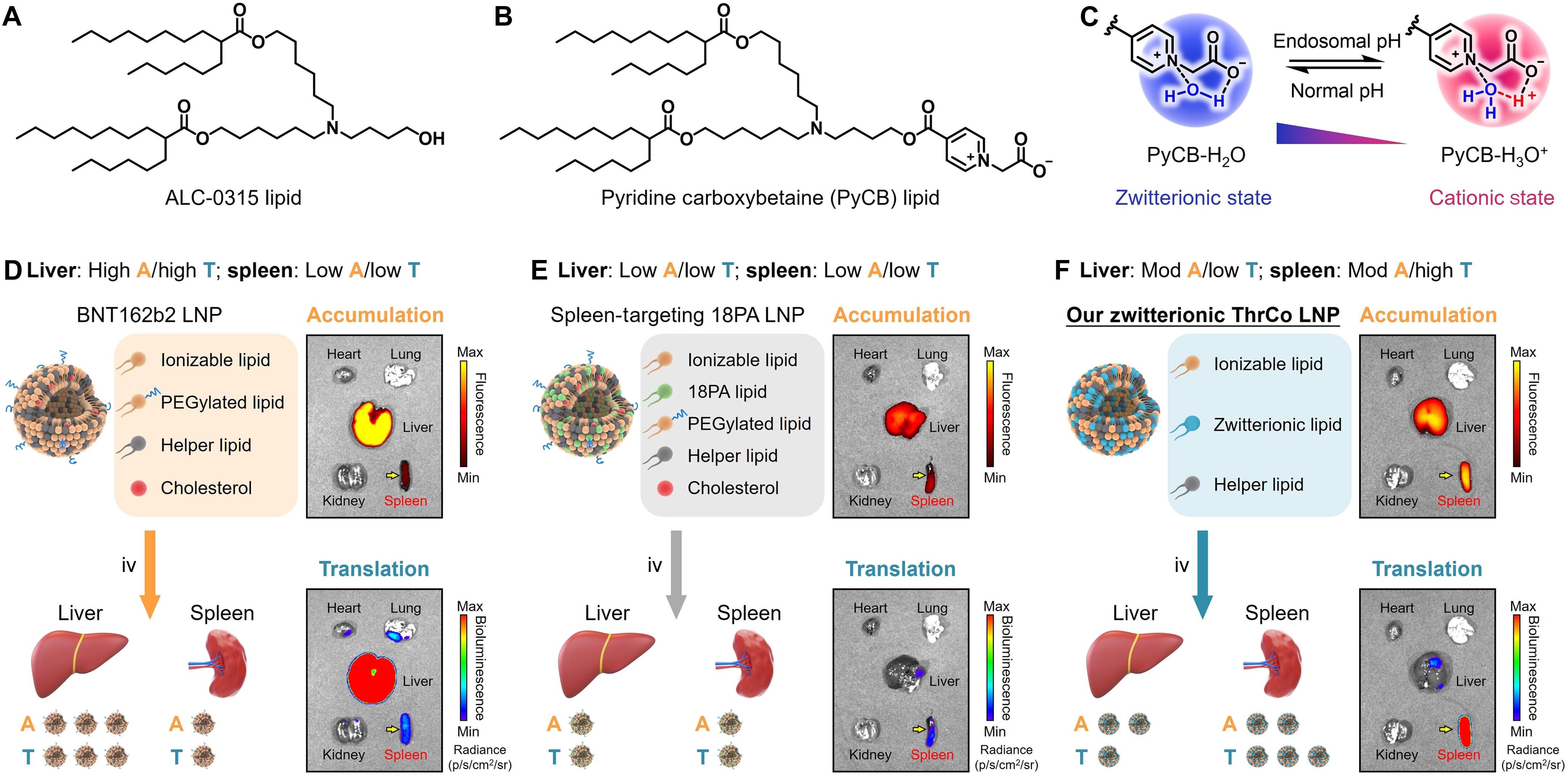Replacing cholesterol and PEGylated lipids with zwitterionic ionizable lipids in LNPs for spleen-specific mRNA translation
IF 12.5
1区 综合性期刊
Q1 MULTIDISCIPLINARY SCIENCES
引用次数: 0
Abstract
The spleen is emerging as a key vaccination target. However, existing lipid nanoparticles (LNPs) primarily accumulate in the liver, limiting their efficacy in vaccine therapy. The cholesterol in current LNP formulations promotes their uptake by hepatocytes, while the polyethylene glycol-modified (PEGylated) lipids induce PEG immunogenicity, further reducing the efficacy in the setting of repeated administrations. We develop a three-component (ThrCo) LNP by replacing cholesterol and PEGylated lipids in Pfizer-BioNTech LNPs with zwitterionic pyridine carboxybetaine (PyCB) ionizable lipids (ILs), achieving ~70% lower liver accumulation and a 4.5-fold increase in spleen-specific mRNA translation. PyCB ILs enhance LNP hydrophilicity, stabilizing the outer membrane to compensate for cholesterol removal. PyCB groups also exhibit strong protonation at endosomal pH, facilitating mRNA translation. The zwitterionic surface of ThrCo LNP reduces protein adsorption, thereby preventing the accelerated blood clearance effect caused by PEGylated lipids following repeated administrations. Thus, ThrCo LNP–based vaccines efficiently deliver mRNA to splenic antigen-presenting cells, boosting immune responses and improving therapeutic outcomes.

在LNPs中,用两性离子可电离脂质代替胆固醇和聚乙二醇化脂质,用于脾脏特异性mRNA的翻译
脾脏正在成为一个关键的疫苗接种目标。然而,现有的脂质纳米颗粒(LNPs)主要积聚在肝脏中,限制了它们在疫苗治疗中的功效。目前LNP配方中的胆固醇促进肝细胞对其的吸收,而聚乙二醇修饰(聚乙二醇化)脂质诱导聚乙二醇免疫原性,进一步降低了重复给药的疗效。我们开发了一种三组分(ThrCo) LNP,用双离子吡啶羧基甜菜碱(PyCB)可电离脂质(ILs)取代了辉瑞- biontech LNP中的胆固醇和聚乙二醇化脂质,肝脏积累降低了约70%,脾脏特异性mRNA翻译增加了4.5倍。PyCB ILs增强LNP亲水性,稳定外膜以补偿胆固醇的去除。PyCB基团在内体pH值处也表现出强烈的质子化,促进mRNA的翻译。ThrCo LNP的两性离子表面减少了蛋白质的吸附,从而防止了重复给药后聚乙二醇化脂质引起的加速血液清除作用。因此,基于ThrCo lnp的疫苗有效地将mRNA传递到脾脏抗原呈递细胞,增强免疫反应并改善治疗结果。
本文章由计算机程序翻译,如有差异,请以英文原文为准。
求助全文
约1分钟内获得全文
求助全文
来源期刊

Science Advances
综合性期刊-综合性期刊
CiteScore
21.40
自引率
1.50%
发文量
1937
审稿时长
29 weeks
期刊介绍:
Science Advances, an open-access journal by AAAS, publishes impactful research in diverse scientific areas. It aims for fair, fast, and expert peer review, providing freely accessible research to readers. Led by distinguished scientists, the journal supports AAAS's mission by extending Science magazine's capacity to identify and promote significant advances. Evolving digital publishing technologies play a crucial role in advancing AAAS's global mission for science communication and benefitting humankind.
 求助内容:
求助内容: 应助结果提醒方式:
应助结果提醒方式:


